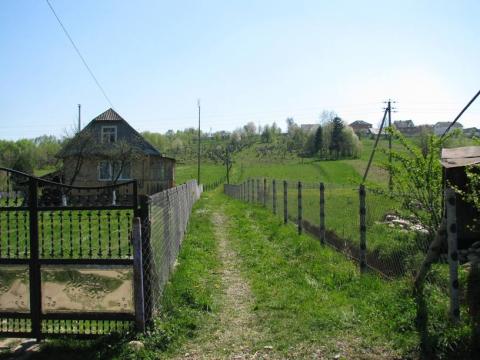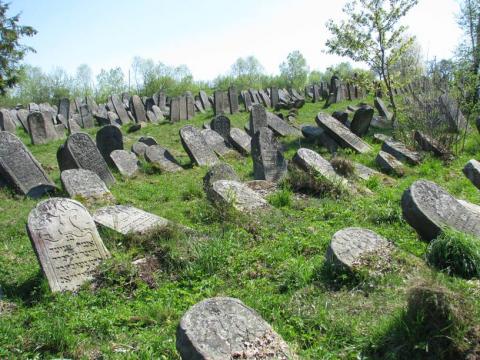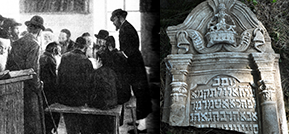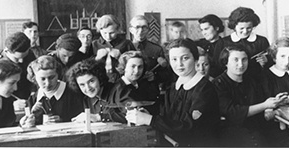
A view of the Solotvin cemetery from far

General view of the Solotvin cemetery
A group of sixteen participants led by Dr. Boris Khaimovich from the Hebrew University of Jerusalem and Marina Bruk from the State University of St. Petersburg undertook the task of documenting the Jewish cemetery in Solotvyn in its entirety. About 2,000 tombstones were numbered, photographed and their epitaphs were transcribed. The work included cleaning the tombstones from the high grass and rubble, sometimes digging out complete slabs. A detailed map of the cemetery was prepared by local land-surveyors. This is the first time that a complete Jewish cemetery was documented in the former Soviet Union. This project shows the continuity of the community from the late seventeenth century up to the Holocaust, and even up to 1997 when the last burial was performed there. Currently we are entering the epitaphs into a computer database in order to upload them to the project's website. This material will be accompanied by English translations and photographs.


Working in Solotvin cemetery
A group of fifteen participants led by Prof. Olga Belova from the Institute for Slavic Studies of the Russian Academy of Sciences and Dr. Maria Kaspina from the Russian State University of the Humanities in Moscow collected oral histories and ethnographic testimonies from local residents. They worked in Solotvyn, Bohorodchany, Nadvirna and the neighboring village of Maniava. Solotvyn turned out to be an ideal place for ethnographic research because there were no large migrations of non-Jews from the town and it preserved its original population. Therefore, older residents remember the pre-war Jewish community and many of its members as well as Jewish customs and the nature of Jewish-Gentile relations. In Bohorodchany and Nadvirna, the number of long-term residents is relatively low due to the influx of people from other places. The one-day visit to Maniava provided an excellent example of a Ukrainian village where only five Jewish families lived before the Holocaust. The older inhabitants of Maniava remember individual Jews but they had little knowledge of Jewish communal life. In addition, members of the ethnographic group visited the towns of Bilshivtsi, Dolina, Horodenka, Kalush, Otyniia, and Tlumach where they collected oral history testimonies from local residents.



The group also conducted interviews with Jews in Ivano-Frankivsk. Although there are no Jewish people there who remember that city before the war, the group collected interesting material from older Jews who came from neighboring regions. Several of the interviews were conducted in Yiddish.
All in all, the group collected 129 interviews, with a total length of 78 hours. 10 hours of interviews were filmed. The majority of the interviews are already transcribed and will soon appear on the website in their original language.
The oral history testimonies collected during the expedition provide us with a unique insight into Jewish culture and life in the years preceding World War II and during the Holocaust. The ethnographic material gathered in the Ivano-Frankivsk region also filled an important gap in the research on Slavic perceptions of Jews and popular views of Jewish customs and rituals.
A group of eight participants led by Hillel Kazovsky from the Hebrew University of Jerusalem and Dr. Volodymyr Lyubchenko from the Institute of History of Ukraine of the Ukrainian Academy of Sciences in Kiev conducted archival and library research in the area. In the library of the State Archives of the Ivano-Frankivsk Region they examined thirty-two local newspapers in order to find information on Jewish life in the area before World War II.
After reviewing the newspapers the group turned to archival materials. Upon the request of our partner organization, the Central Archives of the History of Jewish People in Jerusalem, the group examined material in the collections stored in the State Archives of the Ivano-Frankivsk Region in order to identify Jewish materials and prepare lists for copying.
A member of this group visited the Ivano-Frankivsk Regional Library and copied rare books about towns and villages of the region. These books, mostly written by the amateur historians, were published locally in small numbers and are not easily available in other places. Most of them do not mention Jews but contain essential information about the communities and their history. Twelve books were photographed (891 frames total) and this work has to be continued.
The Rabbi of the Ivano-Frankivsk region Moshe-Leib Kolesnik generously put his personal archives at the disposal of the Field School. A member of the group scanned seventeen large files from Rabbi Kolesnik's archives, which include 927 documents. All collected materials have been uploaded into the project website.
In addition to the above mentioned activities, Dr. Vladimir Levin of the Hebrew University accompanied members of the ethnographic group as it visited nineteen towns in the Ivano-Frankivsk region (Bilshivtsi, Bolekhiv, Broshniv-Osada, Burshtyn, Dolina, Halych, Horodenka, Ezupil, Kalush, Kolomyia, Kosiv, Otyniia, Pereginsk, Pistyn, Rohatyn, Rozhniativ, Tlumach, Tysmenytsia, Yabluniv) in order to survey remnants of Jewish material culture there. During these visits, Dr. Levin also evaluated the possibility of expanding the project's research to include these communities.
The educational part of the field school consisted of three tours and a series of lectures. The first tour of Ivano-Frankivsk was led by a specialist in the history and architecture of the city, Zhanna Komar. During the second educational tour the students visited the town of Halych, after which the region of Galicia was named, and the city of Lviv, the historic capital of Galicia. Miroslav Voloschuk from the Vasyl Stefanyk Pre-Carpathian National University in Ivano-Frankivsk guided the group in Halych, and Igor Smolsky of the State Historical Archives in Lviv led the tour through the old city of Lviv. The third educational tour included visiting Bolekhiv, where Dr. Khaimovich guided the group through the synagogue and the cemetery. The group also visited Stryi, where they viewed the ruins of the Great Synagogue, and Drohobych, where Igor Smolsky guided us through the city center.
Prof. Oleg Zhernokleev of the Pre-Carpathian University in Ivano-Frankivsk, Dr. Victoria Mochalova from the Institute for Slavic Studies of the Russian Academy of Sciences, Prof. Belova, Dr. Kaspina, Dr. Lyubchenko, Mr. Kazovsky, Dr. Khaimovich and Matvey (Motl) Gordon from St. Petersburg gave lectures about Galicia, its Jews and their culture. Dr. Tatyana Velichko from the Ukrainian Academy of Sciences also gave a lecture on Ukrainian ethnography for the ethnographic group. Dr. Khaimovich guided the members of the archival and ethnographic groups through the Solotvyn cemetery.
The three-week field school was generously supported by the Avi Chai FSU Foundation, the Genesis Foundation and the Ludmer Project. We are also grateful to the Ivano-Frankivsk Jewish Community, including Rabbi Moshe-Leib Kolesnik and Director Igor Perelman, for their assistance.






